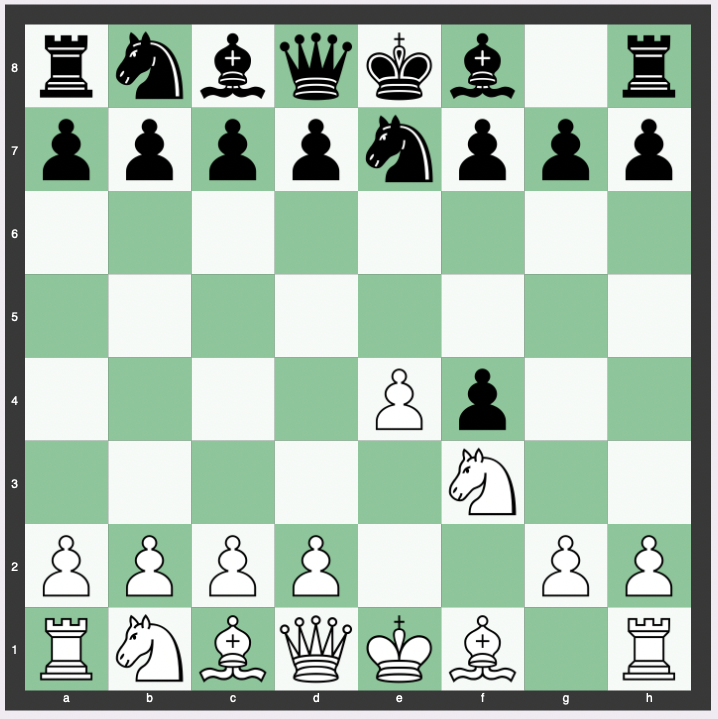The Bonch-Osmolovsky Defense is a seldom-used yet effective maneuver that can change the dynamics of the King’s Gambit.
Although not often played or recognized in popular play, the Bonch-Osmolovsky Defense can be a game-changer when applied correctly.
Here we look into the nuances of the Bonch-Osmolovsky Defense – denoted by the move order: 1. e4 e5 2. f4 exf4 3. Nf3 Ne7
What is the Bonch-Osmolovsky Defense?
The Bonch-Osmolovsky Defense, denoted by the move 3.Nf3 Ne7, is a strategy aiming to defend the f4-pawn with …Ng6, providing a relatively safe square for the knight compared to the Schallopp Defense.

It is named after the Russian chess master, Ivan Bonch-Osmolovsky, who was known for his unconventional yet strategic approach to the game.
While this defense is not regularly used in professional play (largely because the King’s Gambit isn’t commonly played anymore), it does hold its place in the annals of chess history.
The Strategy behind the Bonch-Osmolovsky Defense
The crux of the Bonch-Osmolovsky Defense lies in the move 3…Ne7, which aims to protect the f4-pawn by placing the knight on the g6 square.
This placement serves as a more secure location for the knight when contrasted with the Schallopp Defense, where the knight is typically positioned on f5.
The defense rests on the idea that a knight on g6 not only defends the f4-pawn, but can also exert pressure on the center of the board, disrupting the opponent’s strategy and plans.
Evaluation of the Bonch-Osmolovsky Defense
The Bonch-Osmolovsky Defense is generally evaluated at around +0.10 to +0.00 for white.
Continuation Lines in the Bonch-Osmolovsky Defense
The most popular continuations out of the Bonch-Osmolovsky Defense are:
- 4. Qe2
- 4. d4
- 4. Nc3
Some sample continuation lines of the Bonch-Osmolovsky Defense:
4. Qe2
4. Qe2 Ng6 5. Nc3 d6 6. d4 Be7 7. Nd5 Bg4 8. Qf2 c5 9. Bxf4 Nxf4 10. Nxf4 Bxf3 11. Qxf3 cxd4 12. O-O-O Nc6 13. Kb1 O-O
4. Qe2 Ng6 5. Nc3 d6 6. d4 Bg4 7. Bd2 Nc6 8. Qd3 Be7 9. O-O-O Bf6 10. Ne2 O-O 11. h4 Bh5 12. Kb1 Re8
4. Qe2 d5 5. exd5 g5 6. Nxg5 Qxd5 7. Qb5+ Qxb5 8. Bxb5+ Nbc6 9. O-O Bh6 10. Ne4 O-O 11. c3 f5 12. Nc5
4. Qe2 g6 5. Nc3 Bh6 6. g3 O-O 7. d3 d5 8. Bxf4 Bxf4 9. gxf4 d4 10. Nd1 c5 11. Qd2 Nbc6 12. Nf2 f5 13. h4 Qc7 14. e5 Kh8 15. h5
4. Qe2 g6 5. Nc3 Bh6 6. d4 O-O 7. d5 d6 8. g3 f5 9. Bxf4 Bxf4 10. gxf4 fxe4 11. Ng5 Rxf4 12. Qd2 Qf8 13. O-O-O h6 14. Ngxe4 Nd7 15. Be2 Rh4 16. Rdf1 Nf5 17. Ng3 Ne5 18. Bd3
4. Qe2 g6 5. d4 Bh6 6. Nc3 O-O 7. d5 d6 8. g3 b5 9. a3 Bg7 10. Bxf4 a6 11. h4 Nd7 12. h5 gxh5 13. O-O-O Ng6 14. Rxh5 Nf6
4. d4
4. d4 d5 5. Bd3 dxe4 6. Bxe4 Ng6 7. Bxg6 hxg6 8. Bxf4 Be7 9. Nc3 O-O 10. Qd2 Nd7 11. O-O-O Nb6 12. Rhe1 Bg4 13. Qf2 c6 14. h3 Bxf3 15. Qxf3
4. d4 d5 5. Bd3 dxe4 6. Bxe4 Ng6 7. Bxg6 hxg6 8. Bxf4 Bb4+ 9. c3 Be7 10. O-O O-O 11. c4 Bf5 12. Nc3 c6 13. Qb3 Qb6 14. Rfe1 Qxb3 15. axb3 Bb4 16. Bc7 Na6 17. Ba5 f6 18. Bxb4 Nxb4
4. d4 d5 5. Bd3 dxe4 6. Bxe4 Ng6 7. Bxg6 hxg6 8. Bxf4 Bb4+ 9. c3 Be7 10. O-O Be6 11. Nbd2 O-O 12. Re1 Nd7 13. h3 c5 14. Nb3 cxd4 15. Nfxd4 Bc4 16. Qf3 Nc5 17. Nxc5 Bxc5
4. Nc3
4. Nc3 d5 5. d4 dxe4 6. Nxe4 Nd5 7. Bb5+ c6 8. Bd3 Bb4+ 9. c3 Be7 10. Qe2 O-O 11. O-O Bf5 12. c4 Ne3 13. Bxe3 fxe3 14. Qxe3 Nd7 15. Nf2 Bg6 16. Bxg6 hxg6
ECO C34 King’s gambit accepted, Bonsch-Osmolovsky Variation (White perspective)
The Bonch-Osmolovsky Defense in Notable Games
Perhaps one of the most notable instances of the Bonch-Osmolovsky Defense being used in a high-stakes game is the match between Mark Bluvshtein and former world title finalist Nigel Short at Montreal 2007.
In this game, Bluvshtein used the defense to secure a victory, demonstrating its potential effectiveness against high-caliber opponents.
Although this match didn’t lead to a broader acceptance of the Bonch-Osmolovsky Defense, it certainly showcased its tactical potential.
Reception of the Bonch-Osmolovsky Defense
Despite the defense’s potential effectiveness, it has never been highly regarded by theory. Its unconventional nature and lack of frequent usage in high-level games have led to a certain level of skepticism.
Nevertheless, the Bonch-Osmolovsky Defense is a testament to the diversity of strategies available in chess and a reminder that sometimes unconventional approaches can prove successful.
Conclusion
The Bonch-Osmolovsky Defense serves as a fascinating case study in the world of chess strategies.
While it may not be a commonly-used or highly-regarded tactic, it holds within it a unique perspective on the game and a potential for surprise that can catch even a seasoned opponent off guard.
It’s a testament to the rich complexity of chess, a game where even the less traveled paths can lead to victory.
Whether you are an amateur enthusiast or a professional player, the Bonch-Osmolovsky Defense offers an intriguing, and potentially rewarding, avenue for exploration.


